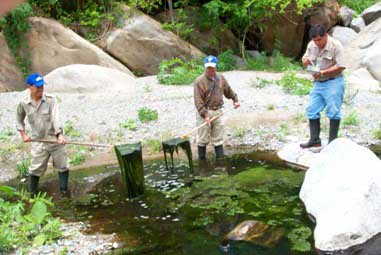| HOMEPAGE | Iridoviruses | Ecology of baculoviruses | Virus insecticides | Spinosad | Predators, parasitoids, pathogens | Others | Students |  | |
Mosquitoes, Blackflies & Ticks (click here for publications in PDF format) | |||||||||
|
| ||||||||
In Mexico, and many other parts of Latin America, the immature stages of An. pseudopunctipennis develop in river pools abundant in filamentous green algae (Spirogyra and Cladophora). The algae represent an important food source and provide a refuge from predators for the mosquito larvae.
This relationship has been described in detail
by Bond et al.
(2005).
As a result, ovipositing females select habitats based on the presence of these algae.
Extraction of algae from these pools results in a marked decrease in the densities of larvae and adult mosquitoes that lasts for 6 – 8 weeks.
This effectively eliminates the mosquito population during the period of peak biting activity of this species in southern Mexico
(Bond et al. 2004). For its simplicity and effectiveness, the intervention has now been incorporated into the Mexican Government’s Health Department guidelines on Epidemiological Monitoring, Prevention and Control (NOM-032-SSA2-2002). Importantly, the intervention can be performed by local communities in affected areas.
Studies on the environmental impact of the
intervention have concluded that algal extraction results in minor changes
in the diversity of aquatic insect communities (Bond
et al. 2006). |
Filamentous algae form floating mats in riverside pools: ideal for the development of Anopheles mosquitoes. | ||||||||
Extraction of filamentous algae results in a dramatic reduction in Anopheles mosquito populations. | |||||||||
| In an on-going collaboration with Drs. Guillermo Bond and Carlos Marina (CRISP-INSP) and researchers in ECOSUR, the efficacy of the sterile insect technique is being evaluated as a method for control of two species of mosquito that are the principal vectors of dengue in Mexico.
For this, large numbers of male mosquitoes have to be reared, sterilized using a radiation source and released into the environment.
Wild females that mate with sterilized males will not be able to produce offspring, resulting in a rapid decrease in the mosquito population.
Recent trials compared the efficiency of ground-based release and drone-mediated release of many thousands of sterile males in a rural zone of southern Chiapas
This study was published by Marina et al. (2022). | ||||||||
| Complete list of publications | Trevor Williams homepage | Sitemap | |||||||
| HOMEPAGE | Iridoviruses | Ecology of baculoviruses | Virus insecticides | Spinosad | Predators, parasitoids, pathogens | Others | Students |  | |


